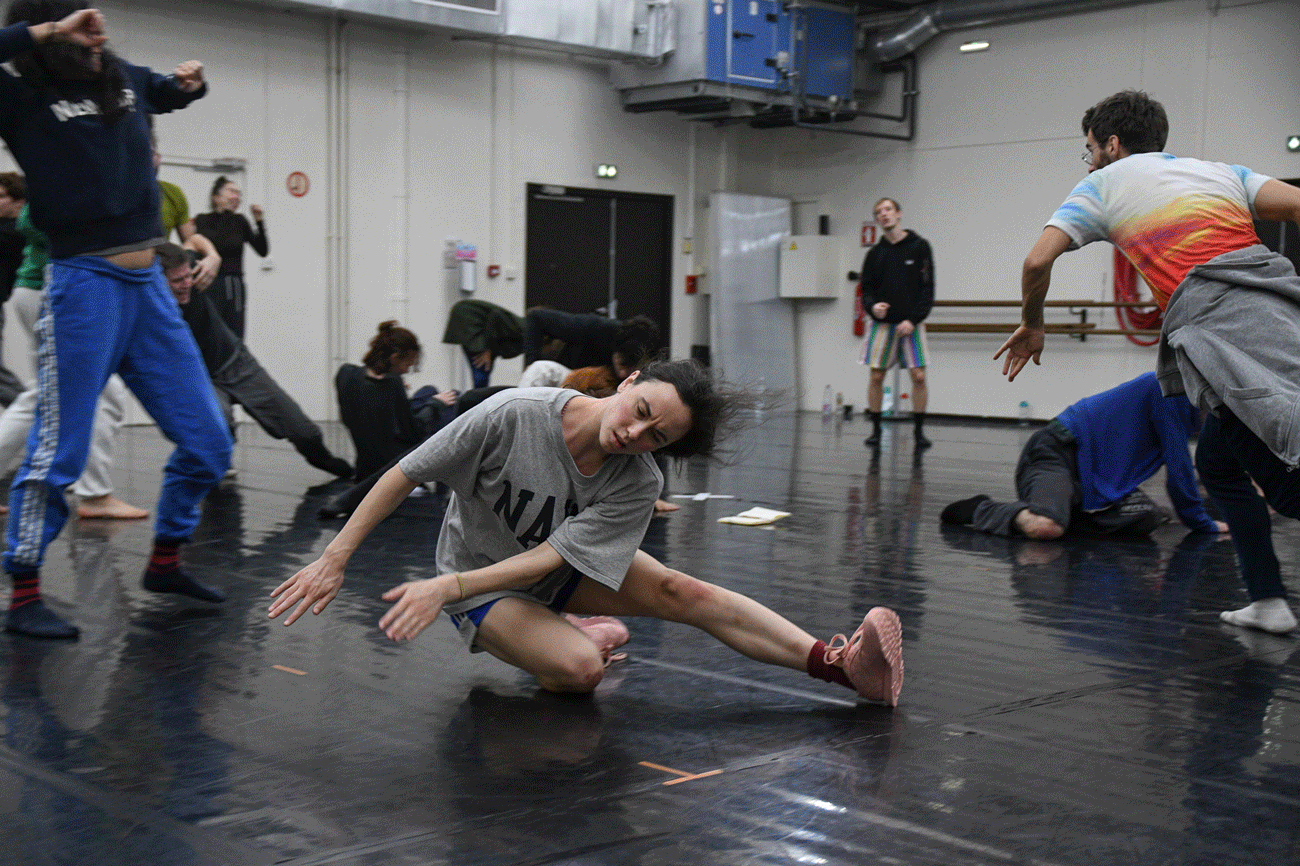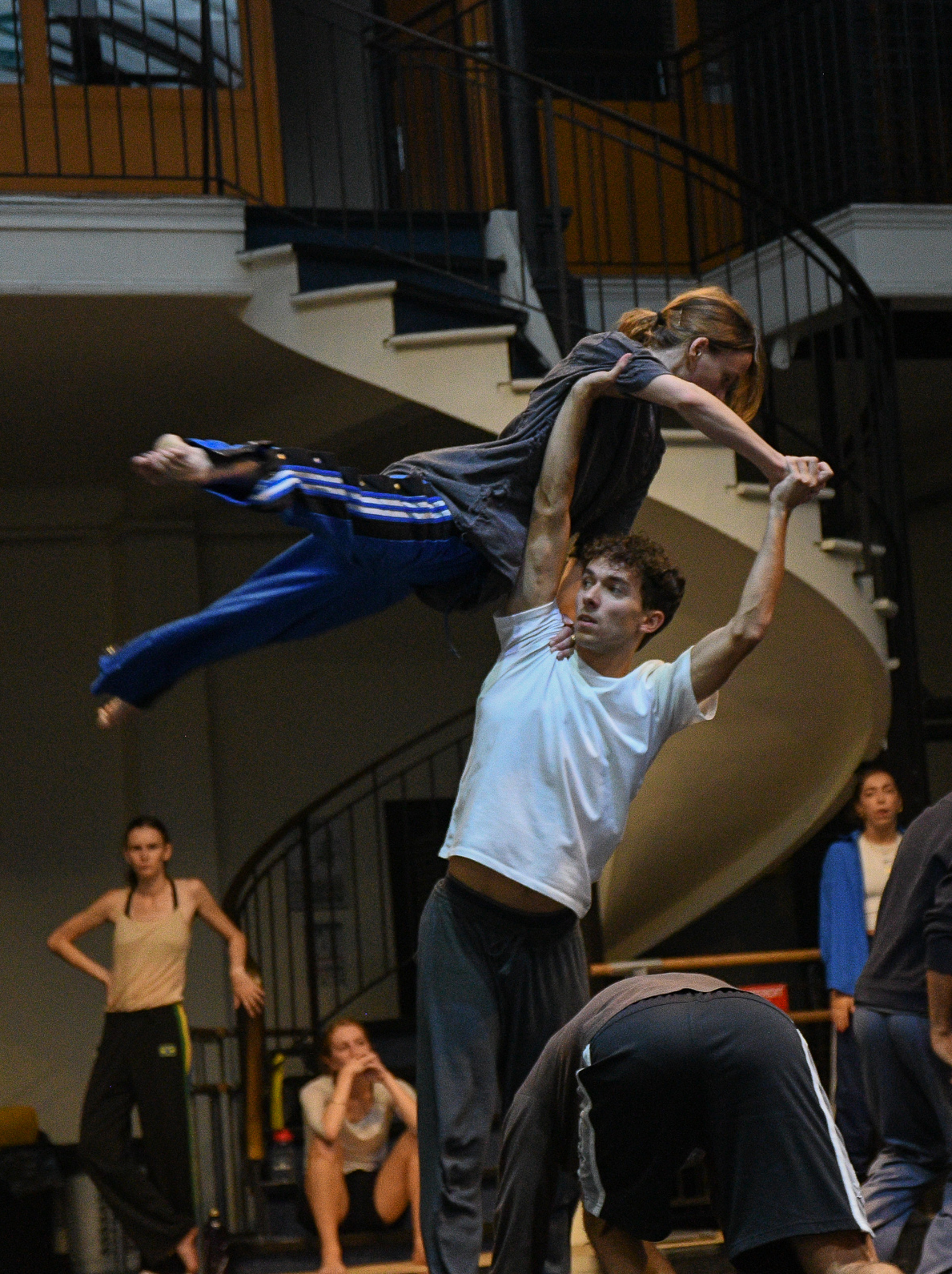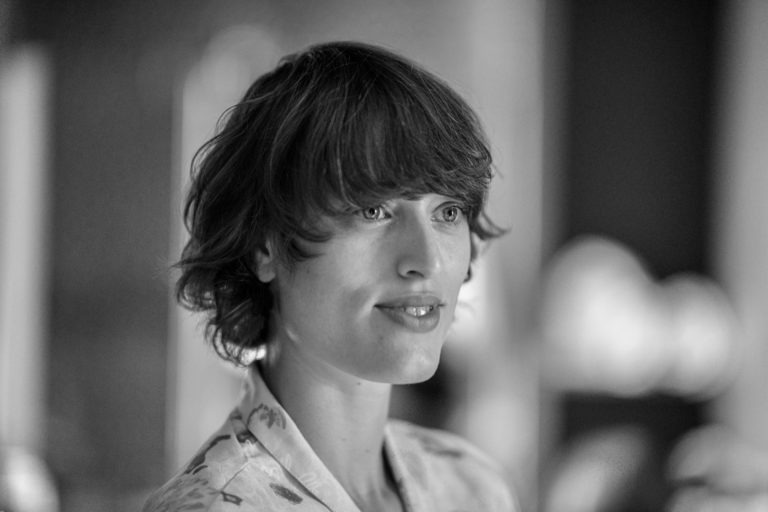Program 2: Trisha Brown & Tatiana Julien
Program 2: Trisha Brown & Tatiana Julien
March 2, 3, 4, 2022 at 8:00PM / March 6, 2022 at 3:00PM
Opéra national de Lorraine (Nancy)
This program is designed as a cross-over between the past and the present, with a restaging of a classic from Trisha Brown and a brand-new creation of a young choreographer well anchored in the present.
On one hand we have Twelve Ton Rose, created in 1996 by the Trisha Brown Dance Company. The piece is inspired and constructed around the music of Anton Webern and features extracts from several opuses for strings that disrupt the movement, creating a surprising choreography that dives into the affinity between the american choreographer and the Austrian composer. On the other hand we have Decay, a very modern piece where Tatiana Julien explores the idea of slowing down, as a reaction to the world’s ever-increasing pace. A return to the notion of taking time - an idea often negatively viewed - and a welcome celebration of idleness.

Twelve Ton Rose
Choreography: Trisha Brown
Music: Anton Webern
Live music: Opéra national de Lorraine musicians
"Twelve Ton Rose (1996) is the second work in Brown’s music cycle, set to Anton Webern’s Opus 5, Opus 7, and Opus 28. The title is a whimsical play on twelve tone rows, a compositional device developed by Arnold Schoenberg and used extensively by Webern. A series of lush ensemble pieces, duets, and solos, the choreography has a deliberate yet poetic relation to the musical structures. Brown and her company, like Webern, exhibited a profound interest in redefining contrapuntal expressions.
Brown noted how the music dissolved in and out and used that as inspiration in her choreography, at times filling the silences and enlivening stillnesses. In most prior works for the proscenium, the company would generate a large body of phrase work “belonging” to each piece to be used as fodder throughout the entirety of the work.
In Twelve Ton Rose, the center sections alone feature movement lines singular to the work. Other materials are drawn from throughout Browns vast repertory and re-framed, multiplied, layered, collided, stretched and condensed; the resulting choreography reflecting Webern’s tendency away from strong tonal centrism and towards abstraction and lyricism. "
Kathleen Fisher

© CCN - BdL
Decay - création
Choreography: Tatiana Julien
I would like to construct the piece Decay as a great generalized slowdown that is shared by the 25 dancers of the ballet. I think of the plane’s braking distance on its runway, the inertia of the liner facing the iceberg, the urgency to turn the tide. Decay is the decline of the day, of the vain race, of the passing of time; it is the gardener who watches the blooming of the flowers and their putrefaction, slow and progressive, in the smallest detail; it is the atomization of movement. To become as dilated as after love, as a long laugh, in the inertia of thought, boredom, sweat after the effort that is no longer to provide.
Rates
Full rates: 1re cat. 35€ / 2e cat. 25€ / 3e cat. 17€.
Reduced rates* : 1re cat. 26€ / 2e cat. 18€ / 3e cat. 12€
Danceclub rate (new): 1re cat. 23€ / 2e cat. 15€ / 3e cat. 10€
More rates
Bookings: billetterie@ballet-de-lorraine.eu / T. +33 (0)3 83 85 69 08
Online bookings
Mesures sanitaires en place à l'Opéra national de Lorraine

ACCOMPANYING THE PROGRAM
"Warming up" the spectator's view
An hour before the performance, Joris Perez, a choreographic artist and community outreach coordinator, reveals some key elements to better understand the work, through a physical approach accessible for all audiences.
March 3-4, 2022 at 7:00PM
Foyer of the Opéra national de Lorraine (Nancy)
Duration: 30 minutes
Rate: free with the reservation of a ticket to the performance (limited availability – sign-up is required)
BORD DE SCÈNE (On stage)
At the end of the first performance of a new work performed at the Opéra national de Lorraine, Tatiana Julien and members of the Trisha Brown Dance Company will speak about their work on the piece, and answer audience questions.
Wednesday, March 2, 2022 - after the premiere
Opéra national de Lorraine (inside the Opera itself)
Duration: 20 minutes
We'll take care of the kids
Parents, now you have a choice! On performances taking place on Sundays, you may either attend the performance with your children, or leave them with us for a fun workshop about the program, directed by Joris Perez, the choreographic artist designated and trained in audience liaison.
Another way to share the season with your family!
Workshop open to children 4 to 10 years old (number of children limited)
Date and time: Sunday, March 6, 2022 / beginning at 2:30 PM
Place: CCN – Ballet de Lorraine (near the Opéra national de Lorraine)
Running time: the length of the performance
Rate: 5 euros/ child with the reservation of a ticket by an adult, for the same date (sign up required in advance)
The choreographers

© Marc Ginot
Trisha Brown
Trisha Brown (Founding Artistic Director and Choreographer) was born and raised in Aberdeen, Washington . After graduating from Mills College in Oakland, California, studying with Anna Halprin and teaching at Reed College in Portland, Oregon, Trisha Brown moved to New York City in 1961. Instantly immersed in what was to become the post-modern phenomena of Judson Dance Theater, her movement investigations found the extraordinary in the everyday and challenged existing perceptions of what constitutes performance. In this “hotbed of dance revolution”, Brown, along with like-minded artists, pushed the limits of choreography thereby changing modern dance forever.
In 1970, Brown formed her company and explored the terrain of her adoptive SoHo making Man Walking Down the Side of a Building (1970), and Roof Piece (1971). Her first work for the proscenium stage, Glacial Decoy (1979), was also the first of many collaborations with Robert Rauschenberg. Opal Loop/Cloud Installation #72503 (1980), created with the fog designer Fujiko Nakaya, was followed by Son of Gone Fishin’ (1981), which featured sets by Donald Judd. The now iconic Set and Reset (1983), with original music by Laurie Anderson and visual design by Robert Rauschenberg, completed Brown’s first fully developed cycle of work, Unstable Molecular Structure. This cycle epitomized the fluid yet unpredictably geometric style that remains a hallmark of her work. Brown then began her relentlessly athletic Valiant Series, best exemplified by the powerful Newark (1987) and Astral Convertible (1989) – pushing her dancers to their physical limits and exploring gender-specific movement. Next came the elegant and mysterious Back to Zero cycle in which Brown pulled back from external virtuosity to investigate unconscious movement. This cycle includes Foray Forêt (1990), and For M.G.: The Movie (1991). Brown collaborated for the final time with Rauschenberg to create If you couldn’t see me (1994), in which she danced entirely with her back to the audience.
Brown turned her attention to classical music and opera production, initiating what is known as her Music cycle. Choreographed to J.S. Bach’s monumental Musical Offering, M.O. (1995) was hailed as a “masterpiece” by Anna Kisselgoff of the New York Times. Brown continued to work with new collaborators, including visual artist Terry Winters and composer Dave Douglas, with whom she created El Trilogy (2000). She then worked with long-time friend and artist, Elizabeth Murray to create PRESENT TENSE (2003), to music by John Cage.
Brown stepped into the world of opera to choreograph Carmen (1986) and again to direct Claudio Monteverdi's L’Orfeo (1998). Since then, Brown has gone on to direct four more operas, including, Luci Mie Traditrici (2001), Winterreise (2002), Da Gelo a Gelo (2006) and most recently, Pygmalion (2010).
Continuing to venture into new terrain, Brown created O zlożony/O composite (2004) for three étoiles of the Paris Opera Ballet, working with long-time collaborators Laurie Anderson and Jennifer Tipton. Forays into new technology created the witty and sophisticated I love my robots (2007), with Japanese artist and robotics designer Kenjiro Okazaki. Her work with Pygmalion produced two dance pieces L’Amour au théâtre (2009) and Les Yeux et l'âme (2011). Brown’s last work, I’m going to toss my arms- if you catch them they’re yours (2011), is a collaboration with visual artist Burt Barr, whose striking set is dominated by industrial fans. The original music is by Alvin Curran.
As well as being a prolific choreographer, Brown is an accomplished visual artist, as experienced in It’s a Draw (2002). Her drawings have been seen in exhibitions, galleries and museums throughout the world including the Venice Biennale, The Drawing Center in Philadelphia, The New Museum, White Cube, Documenta XII, Walker Art Center, Centre Georges Pompidou, Mills College, Musée d'art Contemporain de Lyon, and Museum of Modern Art. Brown is represented by Sikkema Jenkins & Co. in NYC.

© Aurélien Avril
Tatiana Julien
Tatiana Julien is a french dancer and choreographer, graduate of the Paris National Dance Conservatoire and Paris University VIII. In parallel to her work, she has performed and collaborated with Cie 7273, Nathalie Pernette, Thomas Lebrun and Sylvain Prunenec. Today she dances for Olivia Grandville and Boris Charmatz.
In 2011, she founded her company, INTERSCRIBO. At the crossroads of languages, the company explores spectacular hybrid forms for both theater and on-site performances, mixing professionals and amateurs, questioning the artist’s commitment to the world and the role of the spectator/citizen. These creations, often adapted to the architecture of the location, offer engaging devices for the audience and deploys a fantasy of dance that contaminates everywhere, all the time, a dance that creates empathy. Sound, light, and text are its essential elements. The body engages with these immersive landscapes like a piercing cry, crossed by its context, charged with a persistent and vital force.
The company’s first creations, La Mort & l’Extase, Douve, Ruines and Initio, opéra chorégraphique were forms on the outskirts of expressionism. With chiselled, verbal and embodied choreographies. Its more recent creations Turbulence – a choreographed installation for headphones in a non-dedicated space -, Soulèvement (Uprising) – a bi-frontal solo piece on resistance -, and A F T E R – piece for eight performers (postponed due to sanitary crisis) in a collapsing scenography-, continue the exploration of a dance manifest, full and committed, this time in more performative forms and with the integration of the audience within the scenography.
As part of the European Dancing Museums project she created a highlight for dance entitled La Cité (éphémère) de la danse. She invites various choreographers to perform the utopia of a city of dance that connects to its locals. Tatiana Julien created the Prière de ne pas détruire in Louvre Museum and Monumenta performance in the nave of the Grand Palais in Paris. She also performed at the National Gallery in London, the Boijmans museum in Rotterdam, the Gemälde Galerie in Vienna, the museo Civico, the Arte Sella museum in Italy, and at INHA in Paris.
